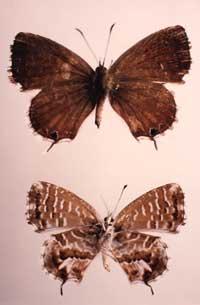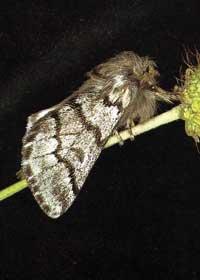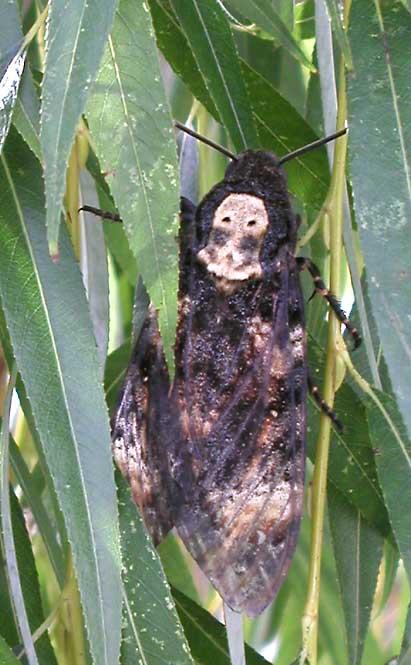Geranium, beautiful for us and sweet for the butterfly
2002/04/28 Mendiburu, Joana - Elhuyar Zientziaren Komunikazioa
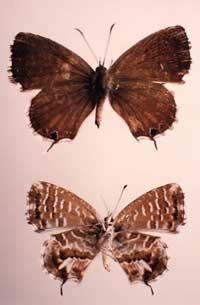
We take advantage of flowers of all colors to decorate the balconies and windows, but in our environment, in all floral species geranium predominates. Unfortunately, for our eyes the flowers of geraniums are a delight for the butterfly Cacyreus Marshalli. And even if that butterfly is African, it does not walk far from our balconies…
Butterflies are mentioned for their color and beauty, but the insect that seems not to harm anyone can be more harmful than it seems, especially when the affected plant is of great economic value.
The African Butterfly in Europe
The butterfly Cacyreus Marshalli is native to southern Africa, but it seems to move more at ease than there. He is not afraid of the cold and, at least in these areas, he has no predators. No wonder you don't want to leave here!
It was first found outside Africa in Mallorca in 1989. The discovery was made by the German entomologist Stamer. The following year, he observed that the population was growing and has since leaked throughout Europe.
Initially there were doubts about whether he entered Mallorca because of a migration, but it seems that the key is in the island's geranium trade. To rule out the hypothesis of migration there were two reasons: on the one hand, not knowing in advance this type of trends in the species and, on the other, not leaving a mark on the long road that goes from its habitual residence to it.
Therefore, it is clear that the butterfly was imported along with the geraniums, although the exact year in which it occurred has not yet been specified. According to some studies, the first eggs were introduced around 1987 and since then it is spreading throughout Europe. It is currently located throughout the Spanish state, France, Italy, Belgium, etc.
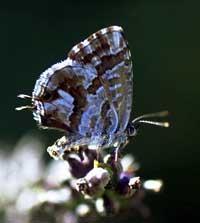
The butterfly belongs to the Lycaenidae family and, although many may say little of that name, there are many butterflies in the Basque Country. Fortunately, all species in this family do not like geraniums.
The butterfly is brown and in the vicinity of the slope has white stripes. Relatively small size, with fins of about 2.5 cm. Most of us will say that it is pretty nice, especially if we do not know that the one that spoils our geraniums is the same!
Is the geranium on my balcony sick?
Normally the butterfly lays the eggs in the floral cocoon, although in some cases it can also put them in the leaves. The eggs are white and smaller than the millimeter. As is known, before becoming a butterfly these eggs will be male. The male or caterpillar is green and four main stadiums on the way to the butterfly. As it passes through these stadiums it develops three longitudinal pink lines.
The first two stages will pass through a flower without expanding until the tissues of the flower are eaten and the flower itself is fully absorbed. In the next two phases, the shortage of food and places will cause the larva to invade the stems. These are the phases in which the most damage occurs, since the larva is greater and more eaten. Finally, the caterpillar passes through a motionless chrysalis phase to become a butterfly.
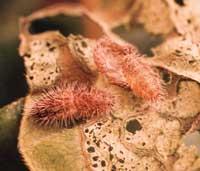
The duration of the entire cycle depends on the temperature, at 20ºC it lasts 62 days and at 30ºC only 33 days. Thus, in the climatic conditions of Mallorca will be generated between 5 and 6 generations a year.
As a result of insect damage, geranium will give very little flower, will be weakened and, in the worst case, the stems will rot full of feces and break.
How to protect geraniums?
The use of insecticides to protect geraniums from the balcony is useless. In fact, insecticides outside the plant do not reach the eggs and fears that are hidden inside. Insecticides that penetrate inside are toxic.
So, for the moment, the only care you can do is take a look from time to time and check if there are the eggs or fears mentioned. If found, the branches will be cut.
Another solution may be the introduction of predatory species from southern Africa to curb butterfly plague. But in these cases it is very difficult to know in advance how the predator will affect and make a balance between benefits and damage. The decision is complicated and meanwhile the butterfly advances in its path with greater losses than expected.
Economic losses
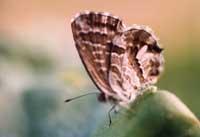
Just look at the balconies in the area to discover the importance of the geranium trade. In Spain, geranium is by far the best-selling in the classification of ornamental flowers. The peninsula has four large producers, with an annual production of 10 million plants. When it reaches the consumer, the economic value of geranium sales is 18 million euros (about 3 billion pesetas).

Gai honi buruzko eduki gehiago
Elhuyarrek garatutako teknologia




